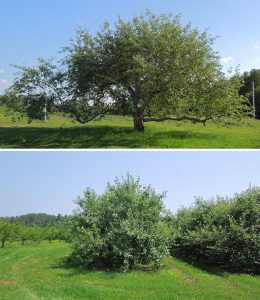Rootstocks and Dwarf Fruit Trees

Fruit trees vary in how large they become when fully grown. Apples, pears, and cherries can range in size from large standard types to dwarf types that are not much bigger than shrubs. Since they remain small even when fully grown, dwarf fruit trees are an option for small yards, or where many different varieties will be planted in a small area. Dwarf types are widely available for most varieties of apple and sweet cherry, but not for pear. Dwarf types do not yet exist for peach, plum or apricot.
The dwarfing trait does not occur in the variety, but in the rootstock to which it is grafted. This means that popular varieties such as Northern Spy can be grown as a dwarf or as a full sized apple tree depending on the type of rootstock.
Fruit trees are grafted to rootstocks rather than being grown from seed. This is because they are not “true-to-type” when grown from seed. Seeds from a McIntosh tree will not grow into another McIntosh tree, but will be a unique variety. This is true of seeds from other fruit trees, as well. In order to propagate trees of a particular variety, one must start with cuttings or buds of that same variety. The McIntosh variety originated over 200 years ago from tree that was grown from a seed. Since then, all other McIntosh trees have been derived from that original tree.
Rootstocks serve as the root system of the tree. Prior to grafting, they start out as complete trees with a root system and a single stem. Bud grafting is usually done in summer when leaf buds on new shoots can be sliced off the stem and inserted under the bark of the rootstock. The grafted bud joins to the rootstock over the next several weeks. After the graft heals, the rootstock is pruned at a point just above the bud. The following spring, the grafted bud will sprout and grow into a new shoot that eventually becomes the fruit-bearing portion of the tree.
There are many different varieties of apple and cherry rootstocks, and they vary in how much dwarfing they induce in the grafted variety. Some are highly dwarfing whereas, some are semi-dwarfing.
In addition to tree size, apple rootstocks affect the age at which they begin to bear fruit. In general, dwarf fruit trees begin to bear two to three years after planting. Semi-dwarf apple trees and most pear trees begin to bear fruit four to five years after planting. Standard apple trees can take as much as seven to ten years to reach an age when they bear fruit. Regardless of the rootstock, peach, plum and cherry trees begin to bear fruit at an age of three to four years.
Dwarf apple and pear trees have weak roots and will not support themselves once they bear fruit. They should be held upright with a stake or trellis so that the roots do not break and for the tree to remain upright. Semi-dwarf trees do not need staking.
